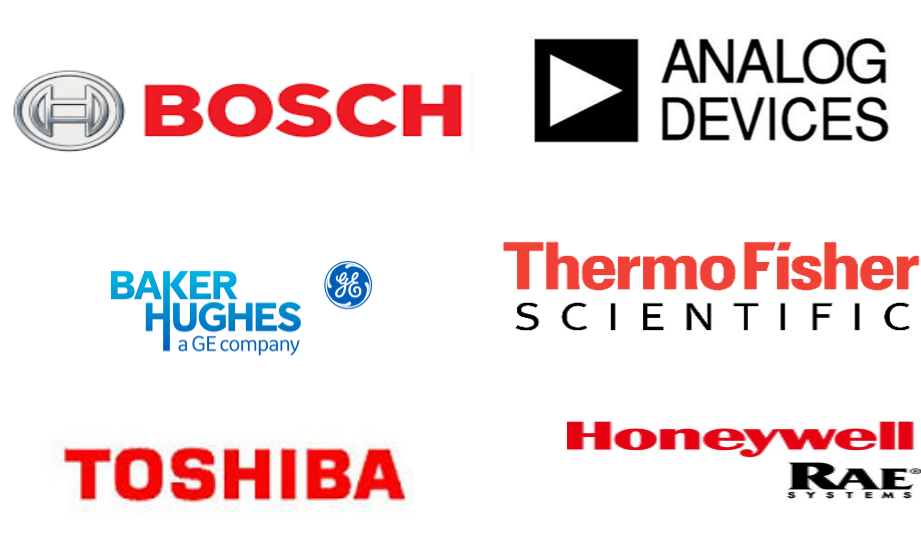Nano Radiation Sensors Market Size and Share
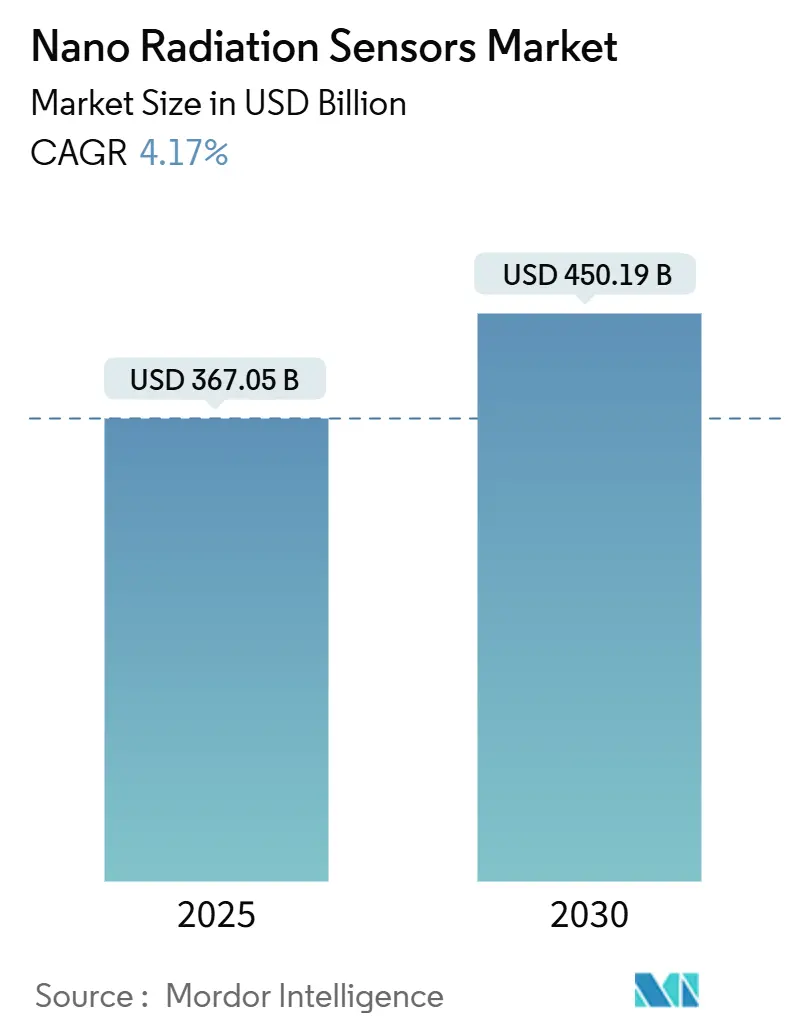
Nano Radiation Sensors Market Analysis by Mordor Intelligence
The nano radiation sensors market stood at USD 367.05 billion in 2025 and is forecast to register a 4.17% CAGR, reaching USD 450.19 billion by 2030. Growth reflects consistent miniaturization across consumer electronics, aerospace, and automotive systems, paired with stringent safety rules in nuclear decommissioning and space exploration. Recent breakthroughs in perovskite semiconductor materials now allow detector footprints small enough for smartphone integration and wearable patches, removing long-standing size and power barriers. Government stimulus ranging from the GBP 30 million package under the UK Nuclear Decommissioning Authority to the USD 105 million CHIPS Act grant for Analog Devices shortens commercialization cycles and accelerates supply expansion. CubeSat proliferation, particularly in university and startup missions, compounds the addressable volume for ultra-light sensors, while parallel demand arises from healthcare dosimetry and automotive safety subsystems. Manufacturing complexity and yield losses remain the most significant constraints; however, firms that resolve material-stability issues while maintaining cost control gain an immediate competitive edge. [1]UK Government, “NDA invests £30 million in decommissioning innovation,” gov.uk
Key Report Takeaways
- By type, solid-state detectors led with 58% of the nano radiation sensors market share in 2024; scintillation detectors are projected to expand at a 6.5% CAGR through 2030.
- By material, silicon-based devices accounted for 46% share of the nano radiation sensors market size in 2024, whereas perovskite devices are poised to grow at an 8.2% CAGR to 2030.
- By application, healthcare held 29.5% revenue share in 2024; automotive is forecast to advance at a 6.9% CAGR through 2030.
- By technology, direct-conversion photon-counting systems captured 42% share of the nano radiation sensors market size in 2024, while flexible perovskite scintillators exhibit an 8.4% CAGR outlook.
- By detection radiation type, gamma/X-ray sensors commanded 51% of the nano radiation sensors market share in 2024 and are expected to grow at a 7.1% CAGR to 2030.
- By form factor, module units dominated with 48% contribution in 2024; wearable patches register the highest 9% CAGR through 2030.
- Regional view: North America retained 35% share of the nano radiation sensors market in 2024, whereas APAC is growing fastest at a 5.9% CAGR to 2030.
Global Nano Radiation Sensors Market Trends and Insights
Drivers Impact Analysis
| Driver | (~) % Impact on CAGR Forecast | Geographic Relevance | Impact Timeline |
|---|---|---|---|
| Miniaturization trend across industries | 1.20% | Global, with concentration in APAC consumer electronics hubs | Medium term (2-4 years) |
| Government nanotech funding & standards | 0.80% | North America & EU, with spillover to allied nations | Long term (≥ 4 years) |
| Growing demand for high-precision healthcare dosimetry | 0.70% | Global, early adoption in developed healthcare systems | Medium term (2-4 years) |
| Nuclear decommissioning & safety regulations | 0.50% | North America & EU, with expansion to aging reactor markets | Long term (≥ 4 years) |
| CubeSat & small-sat adoption of nano-sensors | 0.40% | Global space markets, concentrated in US, EU, China | Short term (≤ 2 years) |
| Flexible perovskite scintillators enable wearable dosimetry | 0.60% | APAC manufacturing centers, global deployment | Medium term (2-4 years) |
| Source: Mordor Intelligence | |||
Miniaturization trend across industries
Relentless downsizing in consumer electronics and automotive platforms pushes radiation sensor modules toward wafer-level integration. Sharp demonstrated a 25 × 20 × 2.5 mm module drawing only 7.5 mW, making smartphone-based radiation tracking practical. Parallel progress in 5 nm and 3 nm process nodes allows logic and detection circuitry to share a common die, lowering bill-of-materials costs for original-equipment manufacturers. In automobiles, compact sensors now fit inside existing electronic control units, supporting Advanced Driver Assistance Systems without altering cabin design. As IoT architectures spread, distributed nano radiation sensors can be deployed in factories and hospitals at node-level costs that were unattainable five years ago. [2]U.S. Department of Commerce, “Preliminary Memorandum of Terms with Analog Devices,” commerce.gov
Government nanotech funding and standards
Targeted public programs guarantee long-term demand while harmonizing certification. The U.S. Department of Commerce earmarked USD 105 million for Analog Devices to modernize three domestic fabs, explicitly citing commercial and defense radiation detection as priority outputs. The UK Nuclear Decommissioning Authority injected GBP 30 million into sensor R & D to support safe dismantling of legacy reactors. In parallel, the European Commission’s Horizon Europe platform directs resources toward sustainable radiation-protection technology. ISO and IEEE working groups now draft unified nano sensor test protocols that cut compliance cycles and enable cross-border procurement.
Growing demand for high-precision healthcare dosimetry
Modern proton-therapy centers and interventional radiology suites need sub-0.1 mm dose mapping to minimize collateral tissue exposure. Lab prototypes employing perovskite detectors have achieved sensitivities of 15,891 µC Gy_air-1 cm-2 and detection limits down to 260 nGy, an order-of-magnitude jump over conventional solid-state dosimeters. The rise of wearable staff monitors improves occupational safety by logging cumulative dose in real time. Coupling sensor streams with machine-learning software allows dose prediction and automatic beam adjustment, reinforcing clinical accuracy while reducing manual recalibration cycles.
Nuclear decommissioning and safety regulations
As reactors in the US, Europe, and parts of Asia reach retirement, plant operators face strict mandates for continuous radiation surveillance. Nano radiation sensors embedded on mobile robots enable remote mapping of hotspots, trimming human exposure and accelerating cleanup schedules. Gallium-nitride–based devices extend operating life under intense radiation, reducing replacement frequency in high-flux zones. Regulatory agencies such as the U.S. NRC now stipulate networked sensor arrays during dismantling phases, making distributed nano platforms a procurement requirement rather than a speculative upgrade.
Restraints Impact Analysis
| Restraint | (~) % Impact on CAGR Forecast | Geographic Relevance | Impact Timeline |
|---|---|---|---|
| Manufacturing complexity & yield losses | -0.90% | Global semiconductor manufacturing centers | Short term (≤ 2 years) |
| High capital cost of nano-fabrication lines | -0.60% | Advanced manufacturing economies | Long term (≥ 4 years) |
| Lack of integration standards across OEMs | -0.40% | Global, with fragmentation in emerging markets | Medium term (2-4 years) |
| Stability issues of perovskite / organic materials | -0.70% | Research-intensive markets globally | Medium term (2-4 years) |
| Source: Mordor Intelligence | |||
Manufacturing complexity and yield losses
Sub-10 nm features needed for latest detector architectures experience higher defect rates than mainstream logic chips, depressing first-pass yields below 60% at several foundries. Supply-chain shocks—such as the temporary shutdown of Spruce Pine’s quartz mine that feeds high-purity silica into photolithography mask blanks—amplify cost pressures by constricting vital materials. Fab operators must adopt tighter particulate controls and advanced metrology, driving up per-wafer operating expenses in the short run.
Stability issues of perovskite / organic materials
Ion migration, moisture sensitivity, and thermal cycling degrade perovskite detectors, causing drift that disqualifies units from critical-safety roles. Encapsulation techniques and grain-boundary passivation improve stability, yet large-scale reliability data remain scarce, forcing extended validation and slowing product launch timelines. The trade-off between flexible form factors and long-term calibration integrity remains the core engineering dilemma for startups entering this segment.
Segment Analysis
By Type: Solid-state Dominance Drives Integration
Solid-state detectors captured 58% of 2024 revenue within the nano radiation sensors market, leveraging CMOS compatibility to embed sensing elements directly onto mixed-signal chips. This architecture trims power budgets and simplifies board layouts, attributes valued in medical imaging consoles and satellite payloads. Scintillation units, though smaller in share, benefit from 6.5% CAGR prospects tied to perovskite nanocrystal breakthroughs delivering light yields above 100,000 photons MeV-1. Hybrid designs now merge solid-state readout with nanocrystal scintillators, achieving sub-400 ps response while retaining wafer-level processing economies.
Second-generation solid-state platforms adopt nano-plasmonic enhancement layers that triple photon-collection efficiency without expanding footprint. As perovskite coatings mature, manufacturers experiment with monolithic integration of high-Z scintillators atop silicon photodiodes, pointing toward single-chip gamma cameras for endoscopic surgery. The evolution indicates that categorical boundaries between solid-state and scintillation approaches will blur, generating new revenue pools throughout the nano radiation sensors industry.
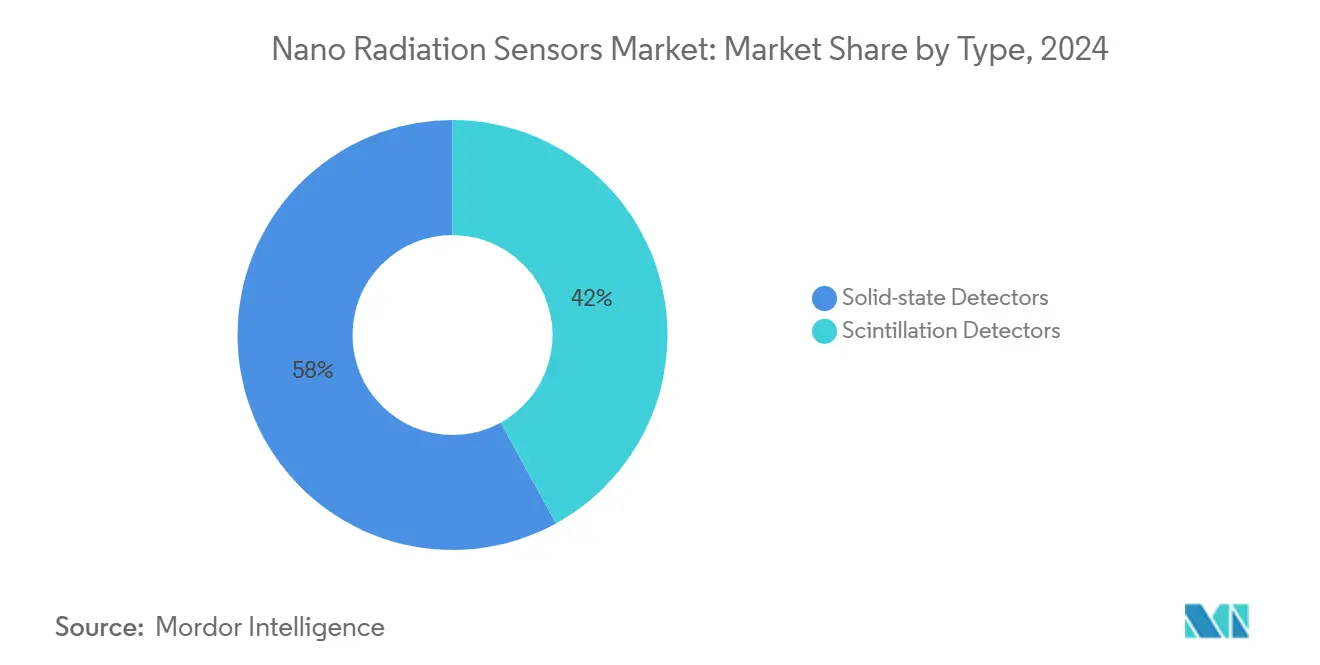
By Material: Silicon Foundation Enables Perovskite Innovation
Silicon maintained 46% contribution to 2024 revenue, offering reliable supply and extensive foundry support that underpins the current nano radiation sensors market size for mainstream applications. Production learning curves keep average selling prices predictable, a trait essential for automotive Tier-1 suppliers committing to decade-long product cycles. Perovskite detectors, at 8.2% CAGR, benefit from solution processing that allows roll-to-roll coating of flexible substrates, widening addressable opportunities in wearable health monitors and drone platforms.
Composite stacks merging silicon ASICs with thin perovskite absorber layers allow detection of soft X-ray and low-energy gamma photons in a single envelope, improving multispectral imaging for nondestructive testing. Lead-free compositions featuring manganese complexes reach photoluminescence quantum yields above 80%, providing an environmental upgrade without sacrificing detection efficiency. These hybrid stacks signal an inflection point where material-choice decisions become application-specific rather than supply-chain constrained.
By Application: Healthcare Precision Accelerates Automotive Safety
Healthcare generated 29.5% of 2024 revenue, as oncology centers increasingly specify nano-level dose-profiling tools. Integration of AI analytics converts real-time counts into adaptive beam modulation, reducing healthy-tissue irradiation. Automotive safety registers the highest 6.9% CAGR thanks to sensor fusion within ADAS platforms, where radiation sensors validate LIDAR and camera function under cosmic-ray exposure during high-altitude driving. Consumer electronics uptake rises through smartphone add-ons that alert users to environmental radiation, a trend boosted by China’s mass-produced 15 mm × 15 mm × 3 mm chip released by CNNC.
Industrial plants adopt networked nano detectors to monitor sealed-source gauges without daily human inspection. Oil-and-gas majors deploy ruggedized neutron sensors for downhole logging, while nuclear power operators embed direct-conversion arrays near reactor cores for continuous flux mapping, evidencing wide cross-industry pull. [3]Source: China Daily, “CNNC Launches Mass Production of Smartphone Radiation Chips,” chinadaily.com.cn
By Technology: Direct Conversion Leads Flexible Innovation
Direct-conversion photon-counting held 42% share of the 2024 nano radiation sensors market size, favored for low-dose imaging where electronic noise suppression is mandatory. Energy-dispersive medical CT scanners, for instance, rely on cadmium-telluride or silicon-drift pixels to improve contrast at reduced patient exposure. Flexible perovskite scintillator panels, growing at 8.4% CAGR, promise garment-integrated dosimetry for nuclear-medicine staff. Indirect scintillation-CMOS cameras dominate baggage-screening lines, while radiation-hardened SoC modules serve cubesat avionics that endure high orbit doses.
Research groups have prototyped DNA-inspired fiber detectors surviving 1,000 stretch cycles while preserving calibration, making them ideal for firefighter turnout gear. The convergence of flexible substrates with ultra-low-power Bluetooth links supports self-organizing sensor swarms across industrial sites.
By Detection Radiation Type: Gamma Dominance Enables Alpha Innovation
Gamma/X-ray devices delivered 51% of total revenue in 2024 and exhibit a superior 7.1% CAGR, reflecting pervasive usage in medical diagnostics, cargo inspection, and nuclear safeguards. Emerging ultrahigh-resolution alpha imagers, attaining 2 µm spatial precision, open market space in semiconductor-cleanroom contamination checks and spent-fuel microanalysis. Beta detectors address radiopharmaceutical dosing in nuclear medicine, whereas neutron counters, employing lithium fluoride converters, remain indispensable for reactor-core monitoring and port-security portals.
Sensor providers increasingly integrate multi-modal stacks—such as layered perovskite-silicon detectors—capable of concurrent gamma and neutron counting, simplifying payload design for lunar surface probes where mass budgets are strict.
By Form Factor: Module Flexibility Drives Wearable Innovation
Modules accounted for 48% of 2024 shipments, striking a balance between performance and drop-in design simplicity for integrators. Standardized pinouts let OEMs refresh detection capability without redrawing system boards. Wearable patches, expanding at 9% CAGR, ride regulatory pushes for continuous staff monitoring in nuclear medicine wards. Textile-based dosimeters convert cotton yarn into active sensing fibers using nano-surface functionalization, delivering comfort equal to everyday clothing.
Chip-scale packages less than 3 mm thick support board-area–constrained applications such as swarming drones. Wide-area panels protect airport checkpoints and scrap-metal yards where coverage overrides miniaturization.
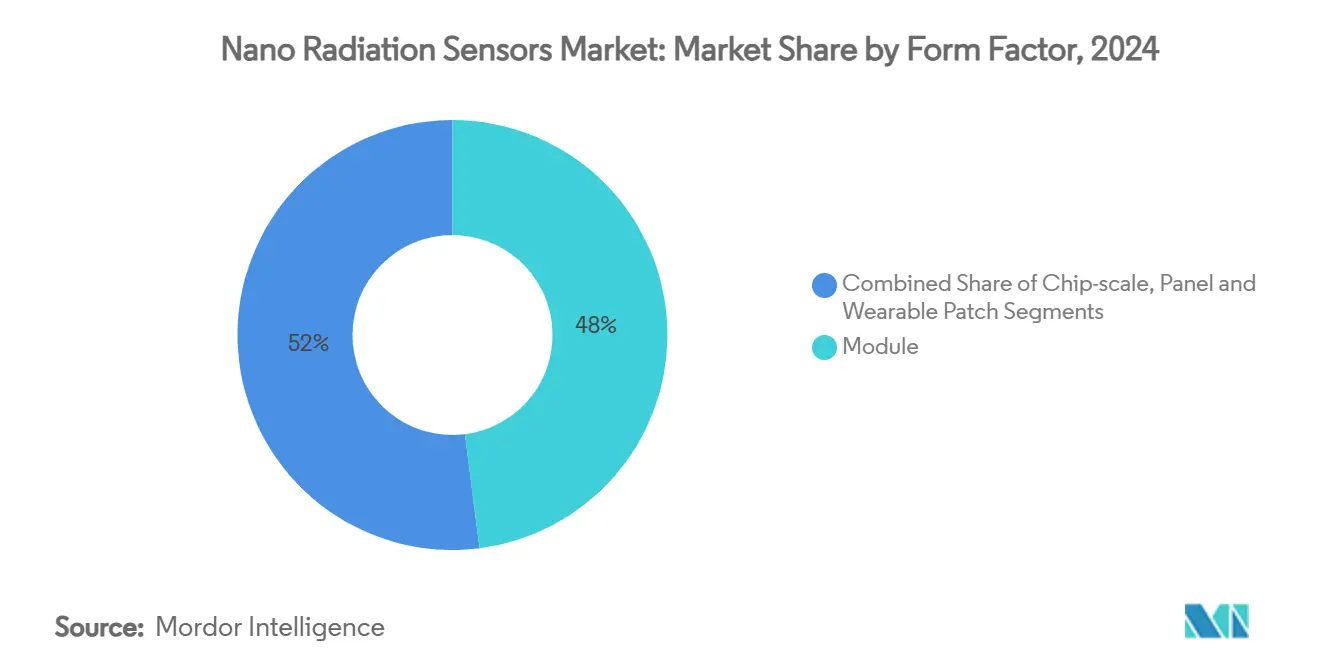
Note: Segment shares of all individual segments available upon report purchase
Geography Analysis
North American leadership, with 35% 2024 share, is anchored by continuous defense procurement and multi-billion-dollar modernization across 93 operating nuclear reactors. Analog Devices is tripling wafer starts in Massachusetts and Oregon under the CHIPS Act, securing long-run availability of military-grade detectors. Thermo Fisher’s enlarged US network of 64 manufacturing sites reinforces domestic supply for healthcare, industrial NDT, and homeland-security programs, while AI-augmented monitoring at two US pressurized-water reactors cuts unscheduled outage hours through predictive analytics.
APAC shows the fastest 5.9% CAGR forecast, underpinned by China’s successful scaling of smartphone-compatible radiation chips, which broaden public-safety adoption. Japan maintains domain expertise via Sharp’s ultra-thin sensor module and JAEA’s silicon gamma-ray detectors qualified for boiling-water reactor retrofits. South Korea’s LEO-DOS payload on NEXTSat-2 validates homegrown radiation-hard designs for low-Earth-orbit dosimetry, signalling export-ready competence for emerging space economies in Southeast Asia.
Europe prioritizes safe dismantling of 171 GW of nuclear capacity set for phase-out before 2050, creating near-term demand peaks for distributed sensor arrays. The UK’s GBP 30 million research grant seeds university–industry consortia to prototype autonomous robotic monitors. Germany’s automotive Tier-1 suppliers explore integrating radiation sensing into ADAS control units to certify electronics against single-event upsets, while France’s EDF upgrades core flux mapping with nano sensors to extend plant licenses beyond 60 years. Finland’s University of Jyväskylä produced a handheld multi-purpose detector that merges neutron, gamma, and beta channels, supporting first-responder toolkits across the continent.
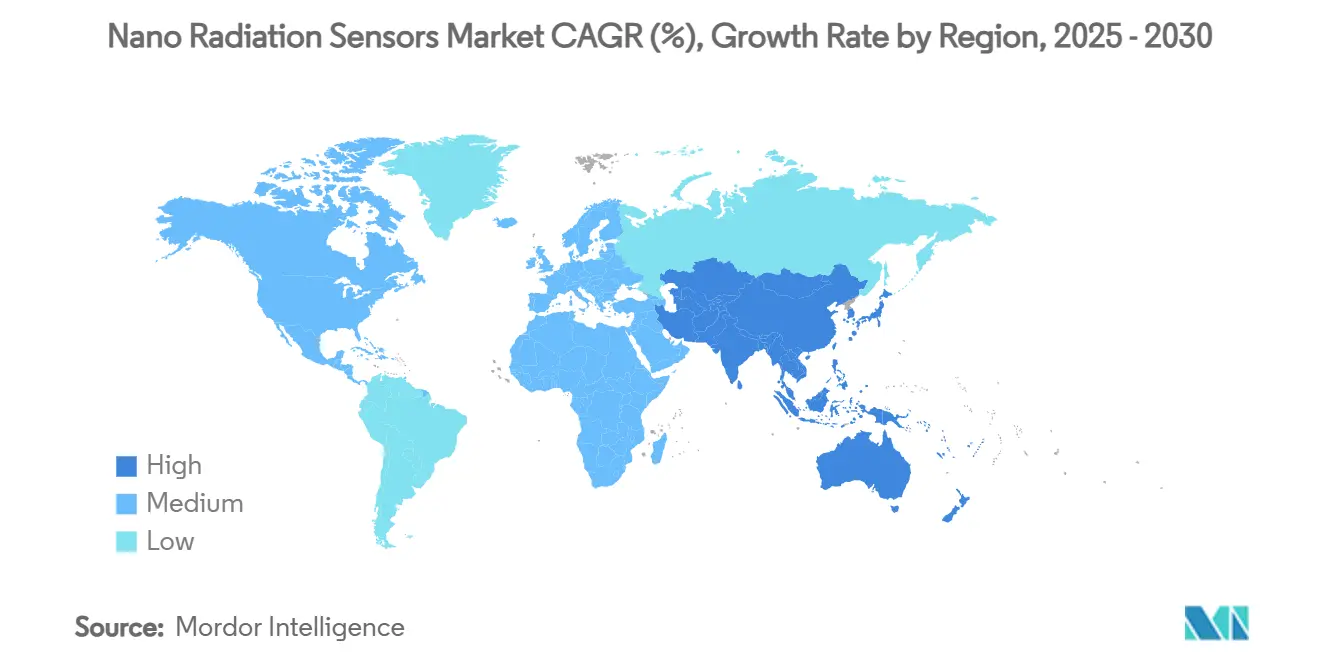
Competitive Landscape
The market features moderate fragmentation. Mirion Technologies, Thermo Fisher Scientific, and Analog Devices leverage vertical integration spanning crystal growth through calibration labs, defending share with broad patent estates. Analog Devices anchors its edge in mixed-signal processing, bundling radiation-hardened front ends with proprietary error-correction IP for military avionics. Thermo Fisher exploits economies of scope across analytical instrumentation to absorb variable demand shocks.
Emerging challengers focus on perovskite stability and flexible substrates. Several Chinese fab-light startups license production to contract manufacturers in Jiangsu, shrinking time-to-market for consumer modules. Bosch’s quantum-sensing joint venture with Element Six extends its automotive portfolio into ultra-precise magnetic and radiation detection by exploiting synthetic diamonds’ defect-center properties. Consolidation continues: Curtiss-Wright’s USD 200 million buyout of Ultra Energy and Teledyne’s USD 710 million Excelitas carve-out add neutron and gamma monitoring portfolios to broader aerospace offerings.
White-space opportunities lie in implantable medical devices where detectors must function reliably at body temperature for 10-year lifespans, and in battery-powered IoT nodes that cap draw under 10 µW. Firms resolving perovskite encapsulation at these operating points could displace incumbent silicon by the decade’s end, reshaping the nano radiation sensors industry. [4]Curtiss-Wright Corporation, “Acquisition of Ultra Energy,” curtisswright.com
Nano Radiation Sensors Industry Leaders
-
Analog Devices Inc.
-
Thermo Fisher Scientific Inc.
-
Hamamatsu Photonics KK
-
Robert Bosch GmbH
-
Mirion Technologies Inc.
- *Disclaimer: Major Players sorted in no particular order
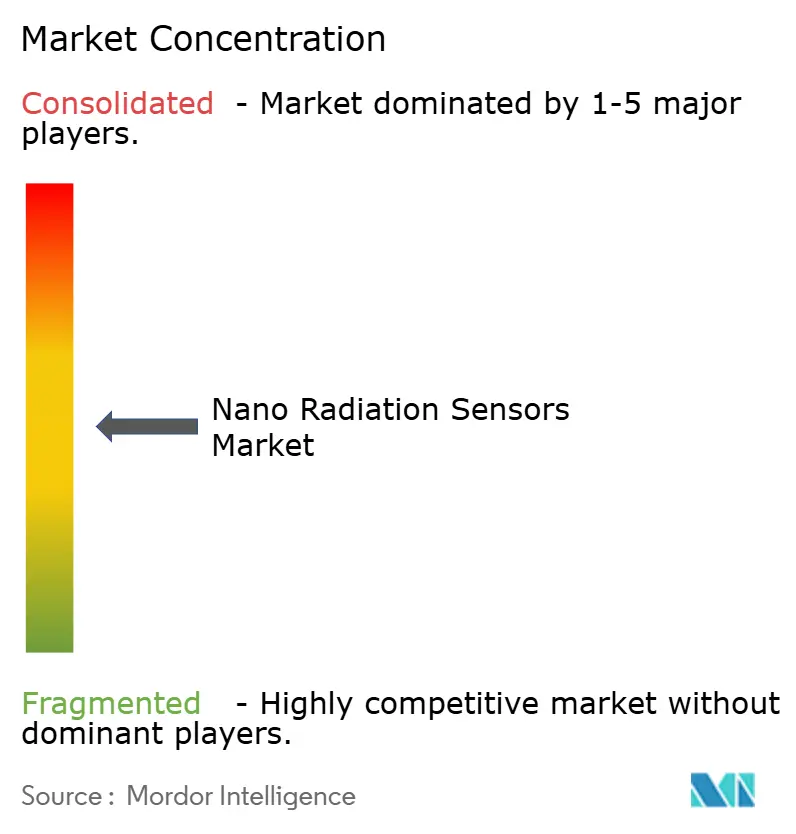
Recent Industry Developments
- April 2025: Thermo Fisher Scientific announced a USD 2 billion US manufacturing and R & D plan spanning 64 facilities.
- April 2025: Bosch formed Bosch Quantum Sensing with Element Six to commercialize diamond-based sensors.
- January 2025: US Department of Commerce preliminarily awarded Analog Devices up to USD 105 million in CHIPS Act funding.
- January 2025: Curtiss-Wright completed the USD 200 million acquisition of Ultra Nuclear Limited and Weed Instrument Co.
Global Nano Radiation Sensors Market Report Scope
Carbon nanotube-based sensors are particularly suitable and promising for chemical and radiation detection because the technology can be used to fabricate gas or liquid chemical sensors that have extremely low power requirements and are versatile and ultra-miniature in size, with added cost benefits.
| Scintillation Detectors |
| Solid-state Detectors |
| Silicon-based Semiconductors |
| Inorganic Crystals (GAGG, LSO, CsI) |
| Perovskite Semiconductors (Lead and Lead-free) |
| Organic / Polymer Scintillators |
| Automotive |
| Consumer Electronics |
| Healthcare |
| Industrial |
| Oil and Gas |
| Power Generation |
| Other Applications |
| Direct-conversion (Photon-counting) |
| Indirect Scintillation-CMOS |
| Flexible / Wearable Panels |
| Radiation-hardened SoC and SiPM |
| Alpha |
| Beta |
| Gamma / X-ray |
| Neutron |
| Chip-scale |
| Module |
| Panel |
| Wearable Patch |
| North America | United States | |
| Canada | ||
| Mexico | ||
| South America | Brazil | |
| Argentina | ||
| Rest of South America | ||
| Europe | United Kingdom | |
| Germany | ||
| France | ||
| Italy | ||
| Russia | ||
| Spain | ||
| Rest of Europe | ||
| Asia-Pacific | China | |
| Japan | ||
| India | ||
| South Korea | ||
| Rest of Asia-Pacific | ||
| Middle East and Africa | Middle East | United Arab Emirates |
| Saudi Arabia | ||
| Turkey | ||
| Rest of Middle East | ||
| Africa | South Africa | |
| Egypt | ||
| Rest of Africa | ||
| By Type | Scintillation Detectors | ||
| Solid-state Detectors | |||
| By Material | Silicon-based Semiconductors | ||
| Inorganic Crystals (GAGG, LSO, CsI) | |||
| Perovskite Semiconductors (Lead and Lead-free) | |||
| Organic / Polymer Scintillators | |||
| By Application | Automotive | ||
| Consumer Electronics | |||
| Healthcare | |||
| Industrial | |||
| Oil and Gas | |||
| Power Generation | |||
| Other Applications | |||
| By Technology | Direct-conversion (Photon-counting) | ||
| Indirect Scintillation-CMOS | |||
| Flexible / Wearable Panels | |||
| Radiation-hardened SoC and SiPM | |||
| By Detection Radiation Type | Alpha | ||
| Beta | |||
| Gamma / X-ray | |||
| Neutron | |||
| By Form Factor | Chip-scale | ||
| Module | |||
| Panel | |||
| Wearable Patch | |||
| By Geography | North America | United States | |
| Canada | |||
| Mexico | |||
| South America | Brazil | ||
| Argentina | |||
| Rest of South America | |||
| Europe | United Kingdom | ||
| Germany | |||
| France | |||
| Italy | |||
| Russia | |||
| Spain | |||
| Rest of Europe | |||
| Asia-Pacific | China | ||
| Japan | |||
| India | |||
| South Korea | |||
| Rest of Asia-Pacific | |||
| Middle East and Africa | Middle East | United Arab Emirates | |
| Saudi Arabia | |||
| Turkey | |||
| Rest of Middle East | |||
| Africa | South Africa | ||
| Egypt | |||
| Rest of Africa | |||
Key Questions Answered in the Report
What is the current size of the nano radiation sensors market?
The nano radiation sensors market was valued at USD 367.05 billion in 2025.
How fast is the nano radiation sensors market expected to grow?
It is projected to expand at a 4.17% CAGR, reaching USD 450.19 billion by 2030.
Which region is growing fastest in nano radiation sensors adoption?
APAC leads with a 5.9% CAGR, driven by consumer electronics integration and new nuclear builds.
What application accounts for the largest revenue share today?
Healthcare holds the leading 29.5% share owing to precision dosage requirements in oncology.
Which technology segment is most dominant?
Direct-conversion photon-counting detectors command 42% of 2024 revenue for their superior energy resolution.
What are the main restraints hindering market expansion?
Yield losses in nanofabrication and long-term stability issues in perovskite materials are the primary constraints impacting near-term scalability.
Page last updated on:
